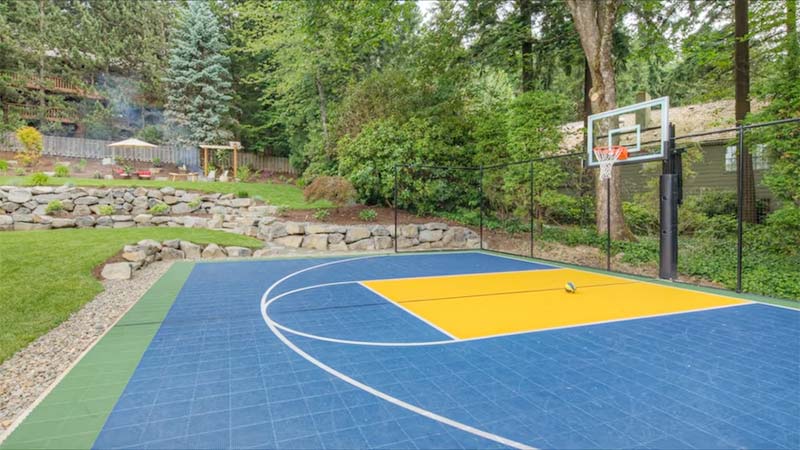Outdoor basketball courts provide a dynamic space for players of all ages to engage in the exhilarating sport. These courts serve as a backdrop for intense matches, friendly pickup games, and basketball skills development.
The materials used in constructing these courts are crucial in determining the overall gameplay experience and the court’s durability.
Additionally, the durability of the court materials determines their ability to withstand the harsh elements of outdoor environments, including exposure to extreme temperatures, rain, and UV radiation.
This article will explore what are outdoor basketball courts made of, discuss maintenance and safety considerations, and explore the design possibilities to help you choose the perfect outdoor basketball court.
What Are Outdoor Basketball Courts Made Of?
Outdoor basketball courts are constructed using various materials that significantly impact the gameplay experience and court durability. Understanding the different court materials available is essential for creating a high-performing and long-lasting basketball court.
Traditional Outdoor Basketball Court Materials
- Asphalt Courts: Asphalt is famous for outdoor basketball courts due to its durability and cost-effectiveness. It provides a hard surface with good ball bounce but can be prone to cracks and unevenness over time.
- Concrete Courts: Concrete courts offer excellent durability and require minimal maintenance. They provide a smooth playing surface and can be customized with color and texture options.
- Acrylic Courts: Acrylic surfaces offer enhanced ball control and shock absorption. They are known for their high-quality finishes, vibrant colors, and excellent traction.
Modern Outdoor Basketball Court Materials
- Rubberized Courts: Rubber surfaces provide excellent shock absorption, reducing the risk of injuries. They offer good ball bounce and traction while resisting cracks and fading.
- Composite Courts: Composite materials, such as reinforced polypropylene, are durable and low-maintenance. They offer excellent weather resistance and can be easily installed and removed.
Factors To Consider When Choosing Court Materials
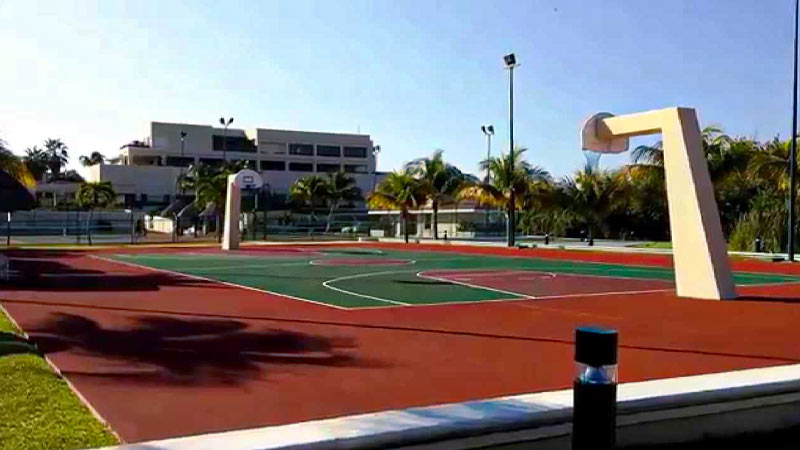
When selecting suitable court material, factors like budget, climate, level of play, maintenance requirements, and durability must be considered. These factors will help determine which material best suits players’ and court owners’ specific needs and preferences.
Maintenance And Care For Outdoor Basketball Courts
Regular cleaning and sweeping are essential for keeping outdoor basketball courts in optimal condition. Repairing cracks and damages promptly, considering resurfacing options, and ensuring proper drainage systems are in place are crucial for extending the lifespan of the court.
Safety Considerations For Outdoor Basketball Courts
Safety features such as clear court markings and lines, anti-slip surfaces, and shock absorption properties are vital for preventing injuries. Additionally, incorporating accessibility features, such as wheelchair-friendly access and appropriate court dimensions, ensures inclusivity for all players.
Design And Aesthetics Of Outdoor Basketball Courts
Outdoor basketball courts offer opportunities for customization and creativity. Choosing color options, incorporating logos and branding, and adding artistic elements and court graphics can enhance the visual appeal and create a unique court atmosphere.
Factors To Consider In Designing An Outdoor Basketball Court
Basketball courts are virtual spaces that require careful planning and consideration during the design phase. Several factors should be considered to ensure a safe, functional, and enjoyable playing experience for all users.
In designing an outdoor basketball court, the following aspects should be addressed:
Location Selection
Choosing the right location for the basketball court is crucial. Factors to consider include proximity to communities, availability of space, and local regulations. Ideally, the site should be easily accessible, well-lit, and away from busy roads or hazardous areas.
Dimensions And Size Requirements
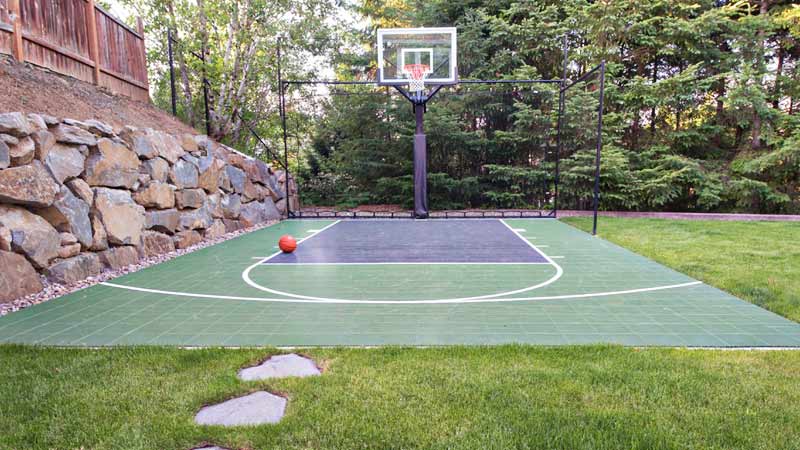
The dimensions of a standard basketball court should adhere to the guidelines set by regulatory bodies, such as FIBA or NBA. This includes court length, width, and height clearance. The size requirements depend on the intended usage, whether a full-sized, half-court, or multi-purpose court.
Safety Considerations
Safety should be a top priority when designing an outdoor basketball court. Proper lighting, slip-resistant surfaces, and adequate spacing between court elements should be incorporated. Additionally, considering the surrounding environment and potential hazards and incorporating safety equipment like padding or fencing is crucial.
Accessibility Features
To ensure inclusivity and accessibility, basketball courts should be designed with features that accommodate individuals with disabilities. This includes wheelchair accessibility, ramps, and appropriate court surfacing to facilitate mobility. Environmental Considerations:
When selecting the location, it’s essential to consider the environmental impact of the basketball court. Factors such as water drainage, tree preservation, and stormwater management should be considered. Using sustainable materials and environmentally friendly construction practices can minimize the ecological footprint.
Community Engagement
Involving the local community in the decision-making process can foster a sense of ownership and encourage active participation. Consulting with residents, schools, and local organizations can provide valuable insights and ensure the design aligns with the community’s needs and preferences.
Budget Constraints
The available budget plays a significant role in determining the design and materials used for the basketball court. Balancing cost-effectiveness with durability and quality is essential. Exploring options like grants, sponsorships, or community fundraising can mitigate budget constraints and enhance the overall design.
Common Materials Used In Outdoor Basketball Courts
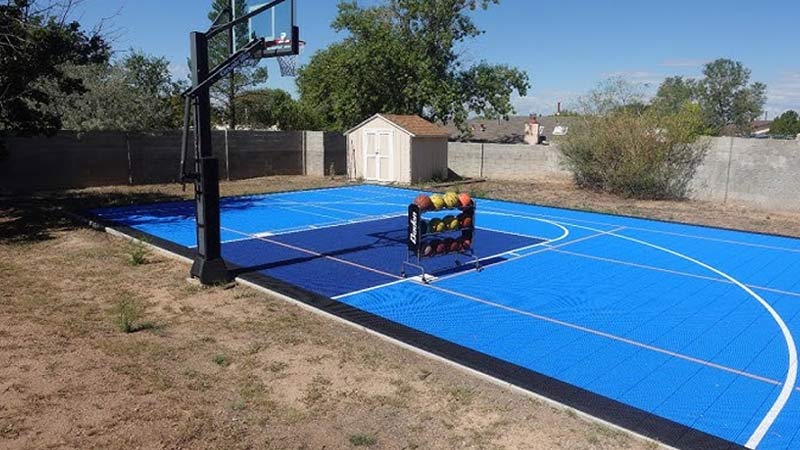
Outdoor basketball courts are constructed using various materials, each with its characteristics, benefits, installation processes, maintenance requirements, and longevity.
Asphalt
Asphalt is widely used for outdoor basketball courts due to its excellent performance and suitability for heavy use. Its characteristics include high impact resistance, good traction, and the ability to withstand varying weather conditions. The smooth surface of asphalt allows players to make quick movements and provides a consistent ball bounce.
Concrete
Concrete is widely used in outdoor basketball court construction for its durability, strength, and versatility. Its solid composition makes it capable of withstanding heavy use and extreme weather conditions. Concrete courts provide a stable playing surface with excellent ball bounce and player traction.
Rubber
Rubber surfaces have become a viable option for outdoor basketball courts due to their durability, shock absorption, and low maintenance requirements. Let’s delve into the details of synthetic rubber surfaces, the advantages they offer for outdoor courts, and the installation and maintenance considerations.
Maintenance And Upkeep Of Outdoor Basketball Courts
Maintaining outdoor basketball courts is crucial for preserving their functionality and aesthetics, ensuring players’ safety, and prolonging their lifespan. This section will delve into the essential aspects of maintenance and upkeep.
Regular Cleaning And Debris Removal
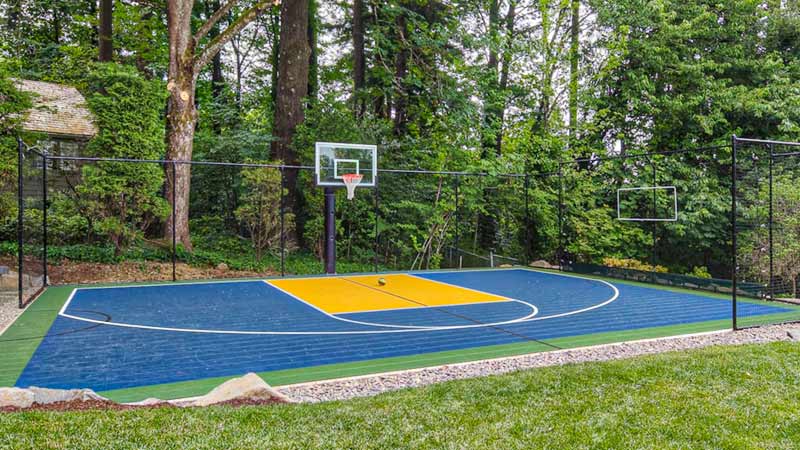
Regular cleaning of the basketball court surface is essential to prevent the buildup of dirt, dust, leaves, and other debris that can affect the court’s traction and player performance.
Sweeping or using a leaf blower to remove loose debris should be done routinely. Additionally, periodic power washing can help remove stubborn stains and grime.
Repairing Cracks And Damages
Over time, outdoor basketball courts may develop cracks, potholes, or other damages that must be addressed promptly. Attempts can compromise the court’s structural integrity and pose safety hazards.
Inspecting the court regularly and repairing cracks using appropriate repair materials, such as crack fillers or resurfacing products, is essential.
Resurfacing Options
Resurfacing an outdoor basketball court becomes necessary when the surface shows signs of wear and tear, extensive cracks, or unevenness. Several resurfacing options are available, including acrylic coatings, rubberized coatings, and modular interlocking tiles.
Each option has benefits and considerations regarding cost, durability, and performance.
Sealing And Coating
Applying a sealant or protective coating to the basketball court surface can help enhance its durability and protect it from weather elements such as UV rays, moisture, and temperature changes.
Sealants and coatings create a barrier that reduces the chances of cracks, fading, and surface degradation, thus extending the court’s lifespan.
Regular Inspections
Regular inspections are essential to identify any potential issues early on. Inspect the court for signs of damage, loose components, or uneven surfaces. Check the condition of the court markings and ensure they are visible and intact.
Additionally, inspect the surrounding areas for vegetation growth that might affect the court’s drainage or pose safety hazards.
Seasonal Maintenance
Seasonal maintenance is crucial to address specific weather-related challenges. In colder climates, it is important to clear snow and ice promptly to prevent water damage and the formation of ice pockets.
Ensuring proper drainage systems and addressing water pooling issues in areas with heavy rainfall is essential to avoid water damage to the court surface.
FAQ
Question: What are outdoor basketball courts made of?
Outdoor basketball courts are typically made of a combination of materials. The playing surface is usually constructed using asphalt or concrete. At the same time, the court lines are painted on top using specialized outdoor court paint.
Question: Why are asphalt and concrete commonly used for outdoor basketball courts?
Asphalt and concrete are famous for outdoor basketball courts for their durability and ability to withstand the elements. These materials provide a solid and stable surface for playing basketball and can handle heavy use over time.
Question: Are there alternative materials used for outdoor basketball courts?
Yes, there are alternative materials used for outdoor basketball courts. Some courts may use rubber or acrylic surfaces, offering improved shock absorption and a more forgiving playing surface. These materials are often used in professional or high-end courts.
Question: Do outdoor basketball courts require any special coatings or finishes?
Outdoor basketball courts may require special coatings or finishes to enhance performance and protect the surface. Acrylic coatings or sealants are often applied to improve traction, prevent fading, and increase resistance to weathering and abrasion.
Question: How are the court lines and markings created on outdoor basketball courts?
Court lines and markings on outdoor basketball courts are typically painted using specialized outdoor court paint. These paints are designed to adhere to asphalt or concrete surfaces and are available in various colors. Precise measurements and stencils are used to ensure accurate placement of the lines and markings.
Conclusion
In this blog, we have explored some common materials used for outdoor basketball courts and their advantages and disadvantages. We have learned that asphalt, concrete, polymeric rubber, and court tiles are some options for building an outdoor basketball court.
Each of them has characteristics that affect the performance and durability of the court. The choice of material depends on factors such as budget, location, preference, and purpose of the court. Outdoor basketball courts are essential for promoting physical activity and community engagement.
Whether you want to build your backyard basketball court or enjoy playing at a public park or school, outdoor basketball courts are a great addition to any outdoor environment.

